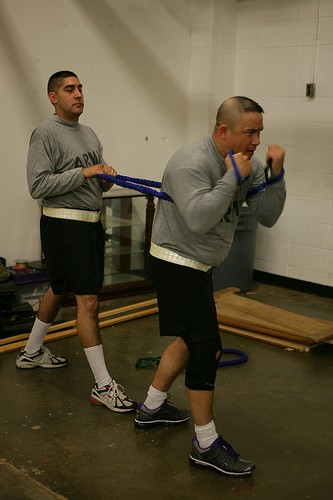
FORT SILL, OKla.--Physical fitness and the Army go together like diets and bikini season. You really shouldn't have one without the other.
Even broken Soldiers need physical training to maintain health, strength and stamina.
Brigade leaders were noticing the lack of treatment of Soldiers on physical training profiles and decided to make a change.
"Colonel [Gregory] Fant (428th Field Artillery Brigade commander) was noticing a big problem with profiles throughout the brigade," said Sgt. Isaias Alvayero, 2nd Battalion, 2nd Field Artillery, HHS battery assistant platoon sergeant. "He spoke to the brigade medics who got us in touch with Lieutenant Colonel Pritchard at RACH. She made up the program itself, and we ended up sending 12 people in the battalion to the classes to become trainers.
"We learned different types and styles of PT for people with profiles," said Alvayero. "Depending on what the injury is, we were showed different ways to strengthen the rest of their bodies without causing further injury."
"Profile PT is for Soldiers with a temporary profile," said 2nd-2nd FA Sgt. Maj. Robert White. "Since Colonel Fant got the idea to train the brigade as a whole on profile PT, the battalion is now doing very well. Every day they have specialized PT. Permanent profile Soldiers are able to do more PT, so they have a different program. If a Soldier comes to us with a profile on his leg, we work out his upper body and do leg aerobics and cycling. That way he still gets some sort of cardio workout."
The 2nd-2nd FA wasn't the only battalion to jump on the profile PT bandwagon.
"The 1-78th is doing the program," said Alvayero, who believes the 1st Battalion, 79th Field Artillery is too.
"We currently have 35 temporary profile Soldiers," said White.
"I have been asking my guys a lot whether or not they have been getting anything out of profile PT and from what they are telling me, each one of them believes the program is helping him out," said Alvayero. "I normally deal with lower back injuries and they are telling me they are getting great workouts without injuring their backs more. I think the program is working pretty well."
Luckily for them, Soldiers on temporary profiles do not have to take PT tests.
"Temporary profiles can last any amount of time, depending on what the provider says," said Alvayero. "It can be two weeks or six months. Recovery time is double what the profile time was. If the Soldier was on temporary profile for six months, the recovery time will be a year in order for them to work their way up."
The program that Pritchard teaches profile PT instructors is "Building the Soldier Athlete." The book covers two phases of PT, the reconditioning or profile phase and the regular phase. Instructors are taught how to care for Soldiers and physically train them despite what injury they may have.

Social Sharing